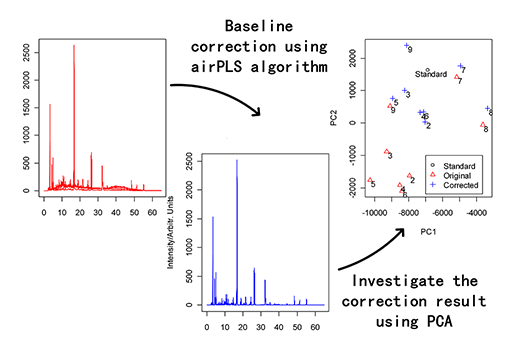adaptive iteratively reweighted Penalized Least Squares (airPLS) algorithm doesn’t require any user intervention and prior information, such as detected peaks. It iteratively changes weights of sum squares errors (SSE) between the fitted baseline and original signals, and the weights of SSE are obtained adaptively using between previously fitted baseline and original signals. This baseline estimator is fast and flexible in fitting baseline.
- Install MATLAB 6.5 or higher in you computer.
- download, unzip and enjoy it from this url.
By taking the advantage of sparse matrix in R package "Matrix", we implemented the sparse version of whittaker smoother and airPLS alogrithm. Now the speed of airPLS 2.0 is faster than airPLS 1.0 by 100 times or more.
-
install airPLS R version from github with following R scripts
install.packages('devtools') library(devtools) httr::set_config( httr::config( ssl_verifypeer = 0L ) ) install_github("zmzhang/airPLS_R")
-
load airPLS package and run example with following R scripts
library(airPLS) ?simulate
Python version of airPLS using the scipy framework by Renato Lombardo of University of Palermo.
-
Install Python Python 3 is recommended https://www.python.org/download
-
Install Numpy, Scipy, Matplotlib with following commands
pip install numpy pip install scipy pip install matplotlib
-
clone this project and run airPLS.py
We have already noticed the parameter optimizing problem in R and Matlab version of airPLS. So we have rewritten this airPLS algorithm in C++ and MFC (Visual Studio 2010) to provide a better user interface for baseline-correction. One can tune the lambda parameter by dragging the slider easily.
- It can be downloaded from this url
- Click the downloaded exe file, install it in your computer and run the installed program.
For any questions, please contact:
Z.-M. Zhang, S. Chen, and Y.-Z. Liang, Baseline correction using adaptive iteratively reweighted penalized least squares. Analyst 135 (5), 1138-1146 (2010).
Download pdf and endnote citation here if you have subscription of RSC
Download manuscript of airPLS here if you doesn't have subscription of RSC



